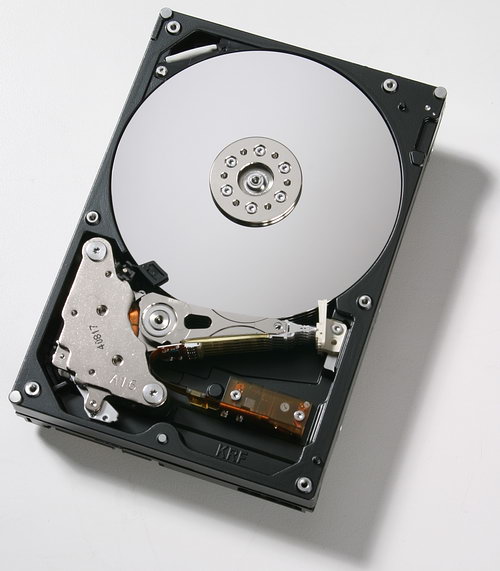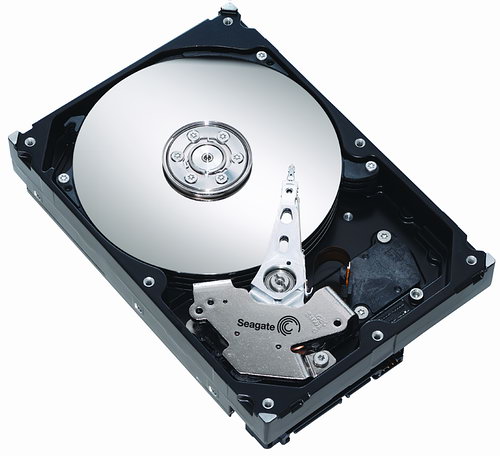 |
||
|
||
| ||
Time has come to sum up what the last year brought in terms of hard disk drives.
Hard Disk Drives for Desktop PCs2005 went out with all the five major manufacturers of 3.5" ATA-drives having finally switched from 80-GB platters to those of a higher capacity. In fact this upgrade had started in the end of 2004. But only Seagate and Maxtor dared to do it (for example, read "Digest 2004"). And all the rest followed them in 2005. That is 100-GB platters were mastered by Hitachi (Deskstar 7K500), Maxtor (DiamondMax 10), Samsung (SpinPoint P120, 200 GB models), Seagate (some Barracuda 7200.8 models), Western Digital (WD3200 and WD4000).  Hitachi Deskstar 7K500 — the first half terabyte hard drive.
Moreover, almost all of them mastered 125 GB platters this year: Hitachi (Deskstar T7K250), Maxtor (DiamondMax 11 and MaXLine Pro 500) and those Samsung drives (SpinPoint P120, 250 GB models), Seagate (Barracuda 7200.8). Only Western Digital is not in a hurry to do it. A number of manufacturers have already developed 133-GB platters: the 3-platter Seagate Barracuda 7200.8 (400 GB) has been known to users for a year already (read our review); Maxtor has recently joined the club with its DiamondMax 11 series, which 400-GB model also has three platters (though the 500-GB model is equipped with four platters). Samsung is close on their heels with its T133 series and the top 400 GB model. And the recently announced Seagate Barracuda 7200.9 series already conquered 160 GB per platter.  Seagate Barracuda 7200.9 — the first hard disk drive with 160 GB platters.
Naturally, the maximum capacity of 3.5" ATA drives has grown: this industry met NY 2005 with 400-GB models (from Hitachi and Seagate) and now we enter 2006 to be able to buy 500-GB models (from Hitachi, Maxtor, and Seagate). Western Digital, who had stuck to 250 GB, launched 320-GB and 4-platter 400-GB models. Only Samsung catches up so far, though the Korean giant still nurtures Napoleonic HDD plans. Interestingly, some manufacturers could have theoretically launched models of a higher capacity: for example, Hitachi's current potential is five 125-GB platters, that is 625 GB; Maxtor's – four 133-GB platters, that is 533 GB; even Seagate could have launched a 666-GB model, having mastered (recalled) the 4-platter design! ;) The question is whether modern customers need it. Even 500 GB models find a very limited market, basically for professional data storage systems… Speaking of HDD capacities, we should also mention cache sizes. The previous initiative in top Maxtor DiamondMax 10 and MaXLine III models this year was taken up by the other manufacturers: this year, top models with 16 MB buffers were launched by Hitachi (Deskstar 7K500 SATA), Western Digital (WD Caviar SE16) and Seagate (top Barracuda 7200.9). However, models with such a buffer are not uncommon among hard disk drives for notebooks and servers. Tests demonstrate that a simple increase of a buffer size from 8 MB to 16 MB does not mean automatic performance growth, as HDD performance is also up to how efficiently HDD firmware can handle this buffer to cache data for reading and writing. For example, Maxtor did a great job thanks to a dual-processor controller (read our review), but will the others do it just as well? Another interesting fact - all manufacturers still design and produce desktop models with 2 MB buffers for the budget segment of the market. And these models are not that much slower than their counterparts with 8 MB buffers. And, of course, Year 2005 saw desktop hard drives developed in three other important consumer parameters – shock resistance, power consumption/heating, and operational acoustic noise. Though compared to previous models, the changes were not as significant.
Serial ATA Interface Progress
Serial HDD interfaces continued to develop last year. The first generation (Serial ATA 1.0) was replaced with the second generation (Serial ATA 2.5) offering 3 GBit/s transfer rate, Native Command Queuing (NCQ) support, Staggered Spin-up, Hot Plug, Port Multiplier, eSATA, and some other useful features. While in 2004 SATA 1.0 was "improved" with NCQ only in some Maxtor and Seagate models, we can rightfully call 2005 "a year of NCQ and 3 Gbit/s", as all HDD manufacturers launched models supporting these functions, though we still cannot speak of full compliance with Serial ATA 2.5 Specifications. However, multiple tests showed that these two key innovations don't always yield practical gain (the gain from 3 Gbit/s transfer rate is insubstantial for desktop systems). Manufacturers even preferred to produce desktop hard drives with disabled NCQ in some cases (for example, Western Digital)! Of course, the new interface was more than adequately supported by host controllers: multiple PCI cards of Serial ATA II controllers (basically on chips from Marvell, Promise, and Silicon Image) appeared on the shelves; starting from spring 2005, system chipsets for motherboards also got integrated RAID controllers supporting Serial ATA 3 GBit/s and NCQ — the pioneers were Intel and Nvidia. On the whole, Serial ATA II is one of the key signs of the last year.
SCSI and the advent of Serial Attached SCSI
Sales of professional data storage systems grew significantly in 2005. Hence the sales increase of hard disk drives for these systems, mostly with Ultra320 SCSI interface. That is the rumours about the forthcoming death of SCSI, as faster modifications of this interface are impossible, are obviously premature. In 2005 we reviewed main representatives of all modern HDD series with Ultra 320 SCSI interface (see multiple reviews at http://www.digit-life.com/storage.html). Even though there appeared no new Ultra320-SCSI models in 2005, the 2004 stock still worked, made customers happy, and yielded profits to manufacturers. We should mention separately the appearance of a new class of 2.5" enterprise storage devices. The initiative was brought forward by Seagate in 2004 in its Savvio 10K.1 series (read our reviews), but it yielded benefits to users in 2005, when there started to appear a proper infrastructure for these drives and Seagate added Fibre Channel and SAS modifications to SCSI Savvio models.  Seagate Savvio 10K.1 — the first 2.5" SCSI and SAS hard disk drive.
Seagate's last-year initiative was taken up by Fujitsu, who launched a SAS modification of the 2.5" enterprise storage drive MAV2073RC. Hard drives of this class will be widely used in compact professional systems (blade servers, servers, 1U and 2U data storage systems). But the long-awaited advent of Serial Attached SCSI (SAS) was the most noticeable 2005 innovation in the field of professional storage devices, its final specifications were approved the last year: some companies announced SAS hard disk drives and a real boom started in mid autumn — most manufacturers of host controllers announced entire lines of RAID controllers for SAS interface, the other HDD manufacturers joining in. Now all the four SCSI-HDD manufacturers offer SAS models as well, though they actually use the same time-proven SCSI hard disk drives with a new interface.  Adaptec products for Serial Attached SCSI.
In the end, we should mention the appearance (to be more exact, the flowering on the market) of another new class of enterprise storage devices — hard disk drives with the rotational speed of 7200 rpm and Serial ATA interface (with NCQ): Maxtor MaXLine III and MaXLine Pro 500, Seagate NL35 and Western Digital Caviar RE2. These hard drives are actually slightly modified (in order to increase reliability and to adapt for RAID use) counterparts of desktop models. They became popular in inexpensive professional storage systems for large volumes of data. These solutions promise to become even more popular in future, especially in the light of the mass appearance of cheap SATA RAID controllers (nearly all chipsets for desktop motherboards offer appropriate features!). That is these reliable professional and rather cheap hard drives can be also used by common users!
Compact hard disk drivesWhat concerns storage devices for notebooks and other mobile uses, including external models, Year 2005 didn't lost its face either, though this segment didn't demonstrate the same boom as in 2004. Manufacturers mostly reaped the fruits of their old projects. I guess, we cannot really call the increase of maximum capacity of these drives from 80-100 to 100-120 GB a grand total of the year, no matter how much some managers want it. :) Among the most outstanding events we should mention the appearance of the Hitachi Travelstar 7K100, the first notebook model to exceed the 50 MB/s linear read threshold,  Hitachi Travelstar 7K100 SATA — the fastest hard disk drive for notebooks.
and the creation of the world-first hard disk drive based on perpendicular magnetic recording — the 1.8" MK8007GAH HDD from Toshiba that also broke a new capacity record for hard disk drives of this form factor. In early 2006 we can expect the first 2.5" hard disk drives based on perpendicular magnetic recording — Seagate Momentus 5400.3, up to 160 GB models. But that's another story for our future reviews.  Seagate Momentus 5400.3 based on perpendicular magnetic recording.
P.S. Seagate + Maxtor = MonstergateAfter this article had been written and composed, we got a piece of news (sad for some people and good for others) about the merger of two giant HDD manufacturers — Seagate and Maxtor. This event happened right before the Catholic Christmas, that's why the response of the western computer community was uncommonly chary - these holidays are traditionally spent somewhere on the Bahamas, Bermudas, or Hawaii. The new web site of the merged company www.seagatemaxtor.com (old Seagate and Maxtor web sites are still available and contain all the information about their products) provides clear explanations on this global event, which actually draws a bottom line not only under 2005, but also under many years of severe competition between these two great HDD manufacturers.  Seagate just bought (merged) one of its sworn competitors for about 2 billion USD, seizing an opportunity when Maxtor's capitalization dropped. Shareholders of the merged company, which will be probably called (for now?) Seagate-Maxtor (at least to recognize Maxtor's old achievements), will get 16% of shares from Maxtor and 84% shares from Seagate. The merger is expected to save about 300 mln dollars a year. Of course, the merger of such giants is a slow process, so the deal is planned to be consummated in the second half of 2006. Up to this time Seagate and Maxtor will act on the market as two separate companies — each with its own range of products, plants, and distribution channels. We'll see what'll come out of it in the end of 2006. We'd like to hope that the newly-born monster of a manufacturer, who currently possesses nearly half the world market of hard disk drives (!), will not become a hostage of its own power and will not share the fate of the previous merged company — Maxtor+Quantum — who fell a victim to poor management and lost nearly all its former marketing passion, even though Maxtor is still one of the leaders in this sphere in technological terms - a tasty morsel for anybody. Who can become the next victim in the HDD market? Let's hope it will not be Hitachi GST, who is currently balancing on the edge. It's a technologically tasty morsel for Samsung (who obviously needs a strong impetus to fulfill its bigshot HDD plans) and even Western Digital. Well, we'll see in 2006...
Write a comment below. No registration needed!
|
Platform · Video · Multimedia · Mobile · Other || About us & Privacy policy · Twitter · Facebook Copyright © Byrds Research & Publishing, Ltd., 1997–2011. All rights reserved. |